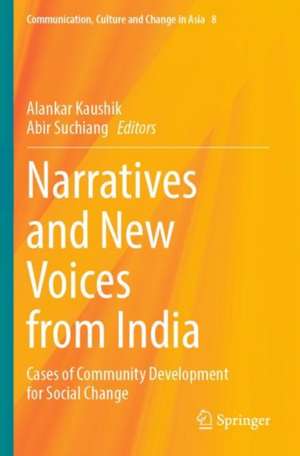Narratives and New Voices from India: Cases of Community Development for Social Change: Communication, Culture and Change in Asia, cartea 8
Editat de Alankar Kaushik, Abir Suchiangen Limba Engleză Paperback – 23 iul 2023
| Toate formatele și edițiile | Preț | Express |
|---|---|---|
| Paperback (1) | 783.35 lei 6-8 săpt. | |
| Springer Nature Singapore – 23 iul 2023 | 783.35 lei 6-8 săpt. | |
| Hardback (1) | 791.09 lei 3-5 săpt. | |
| Springer Nature Singapore – 22 iul 2022 | 791.09 lei 3-5 săpt. |
Preț: 783.35 lei
Preț vechi: 955.31 lei
-18% Nou
Puncte Express: 1175
Preț estimativ în valută:
149.90€ • 156.82$ • 124.52£
149.90€ • 156.82$ • 124.52£
Carte tipărită la comandă
Livrare economică 02-16 aprilie
Preluare comenzi: 021 569.72.76
Specificații
ISBN-13: 9789811924989
ISBN-10: 9811924988
Ilustrații: XXI, 318 p. 42 illus., 37 illus. in color.
Dimensiuni: 155 x 235 mm
Greutate: 0.48 kg
Ediția:1st ed. 2022
Editura: Springer Nature Singapore
Colecția Springer
Seria Communication, Culture and Change in Asia
Locul publicării:Singapore, Singapore
ISBN-10: 9811924988
Ilustrații: XXI, 318 p. 42 illus., 37 illus. in color.
Dimensiuni: 155 x 235 mm
Greutate: 0.48 kg
Ediția:1st ed. 2022
Editura: Springer Nature Singapore
Colecția Springer
Seria Communication, Culture and Change in Asia
Locul publicării:Singapore, Singapore
Cuprins
Introduction.- Part I: Community Centered Development and Shifting Paradigms.- Chapter 1. Politics of Development and its Shifting Paradigms, Addressing the Politics of Community Centered Development Approaches over the Years.- Chapter 2. The relevance of Rabindranath Tagore and Paulo Freire for Participatory Communication.- Chapter 3. The Politics of Development Paradigms: The Relevance of Community-Centered: Approach to Development in the Wake of the Fourth Industrial Revolution.- Chapter 4. Experience and Knowing : Rational and Knowledge.- Part II: Community Voices and Narratives.- Chapter 5. Enabling People to Participate in Development and Social Change through ‘Forum Theatre’: A Case of Jana Sanskriti in West Bengal, India.- Chapter 6. Safeguarding ‘Desia’ Culture through Community Radio : A Cultural Analysis of Radio Dhimsa in Koraput, Orissa.- Chapter 7. Gender Sensitive Programming and Practices among Community Radio in India: An Analysis of International Guides and Policies.-Chapter 8. Development and Community Radio : Uneasy Bedfellows.- Part III: Community Voices of Northeast India: Practices in Development process.- Chapter 9. Participatory Video as a tool for Social Change : Insights from the Khasi Community in Meghalaya.- Chapter 10. Community Radio Platform to promote voice and culture: A case study of Hajong Community from Dhemaji, Assam.- Chapter 11. Greenhub Project on Young Filmmakers from NE India.- Chapter 12. Community Media Practices in the NE India.- Chapter 13. Towards SDG 5 : The Interplay of Gender Power Relations among the Khasi Tirbes in Matrilineal Meghalaya.- Chapter 14. Traditional Healing Practices in Thailand with a special focus on Lanna or the Eight Northern Provinces, and their implications for Holistic Health Communication.- Chapter 15. Contribution of Traditional Medicines towards Primary Healthcare in Meghalaya.- Chapter 16. Decoding the Community Paradigm : Participation and Community Health in the Northeast India.- Part IV: Health Communication for Social Change.- Chapter 17. Nutrition Communication- Experiment for a Researcher, Experience for a Practitioner but Exasperation for People?.- Chapter 18. Adolescent Health, Well-Being, and Empowerment: Participation and Decision Making as Key Elements : Field Experience from rural Gujarat.- Chapter 19. Infant and Young Child Feeding Practices in India and Poshan Abhiyaan – A Case Study from Northern India.- Chapter 20. Developing Scientific Temper on Health among Tribal Women in Tamil nadu.- Chapter 21. Food Safety in Nutrition Transition.- Chapter 22. Dietary Diversity and Non- Communicable Diseases.
Notă biografică
Alankar Kaushik is a faculty at the Journalism and Mass Communication department at EFL University, Regional Campus, Shillong. His current work is on co-creating future strategies in Assam from grassroots stories in the context of Covid -19 and internal migration.
Abir Suchiang is a faculty at the Journalism and Mass Communication department at EFL University, Regional Campus, Shillong. His research focuses on visual culture and most particularly in visual literacy and photojournalism. He is currently working on a book project on Photojournalism in India and its ethical approach and practices.
Abir Suchiang is a faculty at the Journalism and Mass Communication department at EFL University, Regional Campus, Shillong. His research focuses on visual culture and most particularly in visual literacy and photojournalism. He is currently working on a book project on Photojournalism in India and its ethical approach and practices.
Textul de pe ultima copertă
This volume focuses on indigenous knowledge in analyzing the traditions and communication processes within various communities of Northeast India. It deals with the historical and theoretical trajectory of communication for social change as a discipline, bringing together a series of interesting case studies from the sphere of meaningful learning where individuals and communities engage in a cooperative and dialogic environment to promote change at multiple levels. The case studies cover a range of media - radio, video, ‘forum theatre’ - and considers both practitioners and audiences. The authors’ focus on narration, diversity, participation, and interaction is timely, and expands knowledge relating to these areas by linking them in new ways. It is of interest to an academic audience as well as practitioners researching and working in areas of education, communication, community development, and social work.
Caracteristici
Emphasises both a theoretical foundation and practical application to community voices for social change Finds sustainable solutions for community media projects by learning from each other Features a special section on health communication with narratives from underrepresented indigenous communities in India








